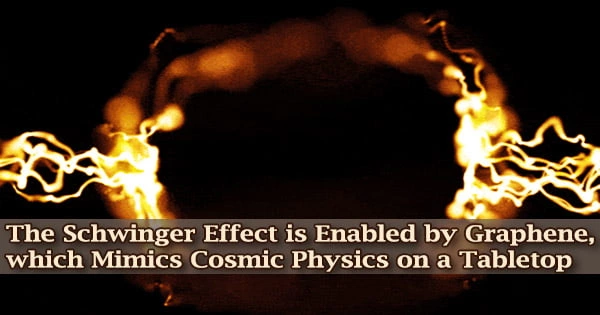The so-called Schwinger effect, which generally only occurs in cosmic events, has been observed by researchers at The University of Manchester. The National Graphene Institute’s team succeeded in creating particle-antiparticle pairs from a vacuum by applying strong currents through specially built graphene-based devices.
A vacuum is thought to be a completely empty space that is devoid of all matter and fundamental particles. However, Nobel Laureate Julian Schwinger predicted 70 years ago that powerful electric or magnetic fields can spontaneously break down the vacuum and form elementary particles.
This necessitates really cosmic-strength fields, such as those found around magnetars or those generated transitorily during high-energy charged-nuclei collisions. Experimenting on these theoretical predictions has long been an aim of particle physics, and some are currently being planned for high-energy colliders throughout the world.
Now, a research team led by another Nobel laureate, Prof Sir Andre Geim, has utilized graphene to simulate the Schwinger generation of electron and positron pairs in partnership with colleagues from the United Kingdom, Spain, the United States, and Japan.
They write in the January 2022 issue of Science that specially engineered devices, such as tiny constrictions and graphene superlattices, allowed them to create extremely powerful electric fields in a simple, table-top arrangement.
The spontaneous generation of electron and hole pairs (holes are the solid-state analogues of positrons) was clearly observed, and the process’ details matched theoretical predictions.
When we first saw the spectacular characteristics of our superlattice devices, we thought ‘wow … it could be some sort of new superconductivity.’ Although the response closely resembles that routinely observed in superconductors, we soon found that the puzzling behavior was not superconductivity but rather something in the domain of astrophysics and particle physics. It is curious to see such parallels between distant disciplines.
Dr. Roshan Krishna Kumar
The researchers also discovered another unexpected high-energy activity with no precedent in particle physics or astrophysics. They accelerated electrons to the highest velocity allowed by graphene’s vacuum, which is 1/300 of the speed of light, in their simulated vacuum.
Something seemingly unthinkable happened at this point: electrons appeared to become superluminous, providing an electric current greater than permitted by general quantum condensed matter physics principles.
This effect was described as the result of the spontaneous production of extra charge carriers (holes). The study team’s theoretical account of this process differs significantly from Schwinger’s for empty space.
“People usually study the electronic properties using tiny electric fields that allow easier analysis and theoretical description. We decided to push the strength of electric fields as much as possible using different experimental tricks not to burn our devices,” said the paper’s first author Dr. Alexey Berduygin.
Co-lead author Dr. Na Xin added: “We just wondered what could happen at this extreme. To our surprise, it was the Schwinger effect rather than smoke coming out of our set-up.”
Dr. Roshan Krishna Kumar, another leading contributor, said: “When we first saw the spectacular characteristics of our superlattice devices, we thought ‘wow … it could be some sort of new superconductivity.’ Although the response closely resembles that routinely observed in superconductors, we soon found that the puzzling behavior was not superconductivity but rather something in the domain of astrophysics and particle physics. It is curious to see such parallels between distant disciplines.”
The study is especially significant for the development of future electronic devices based on two-dimensional quantum materials, as it establishes limits on graphene wiring, which was previously recognized for its extraordinary capacity to support ultra-high electric currents.





